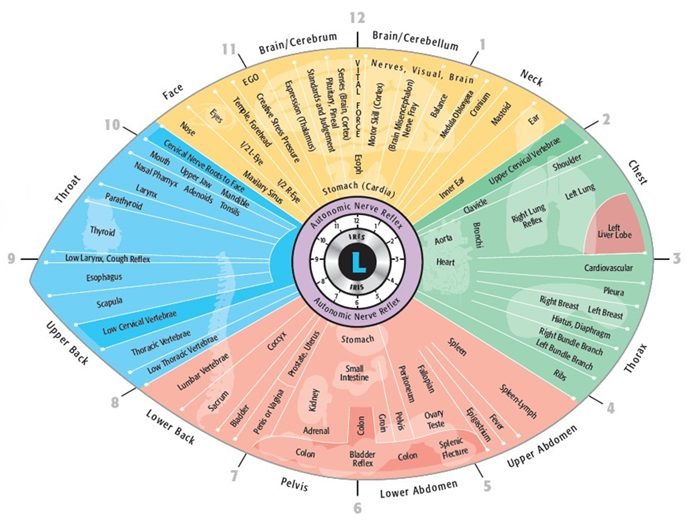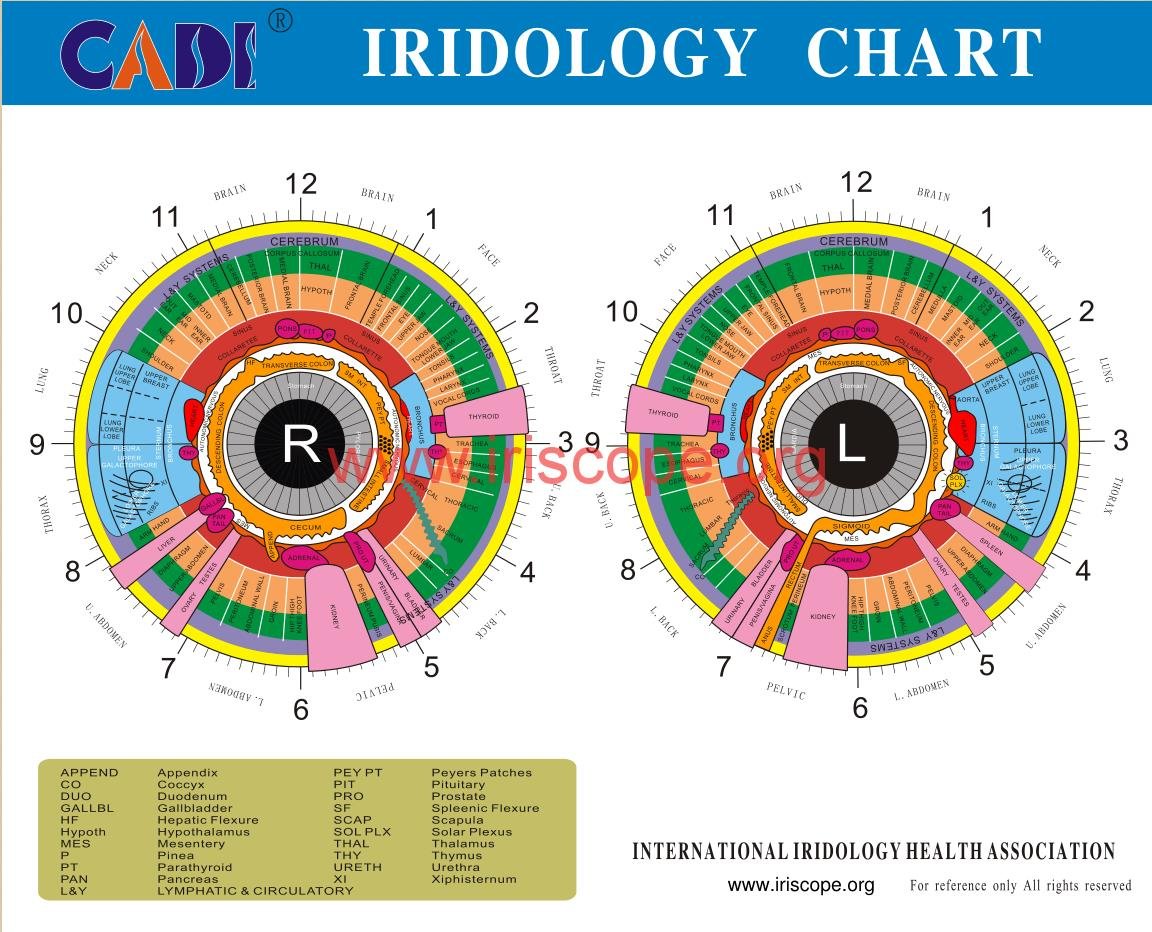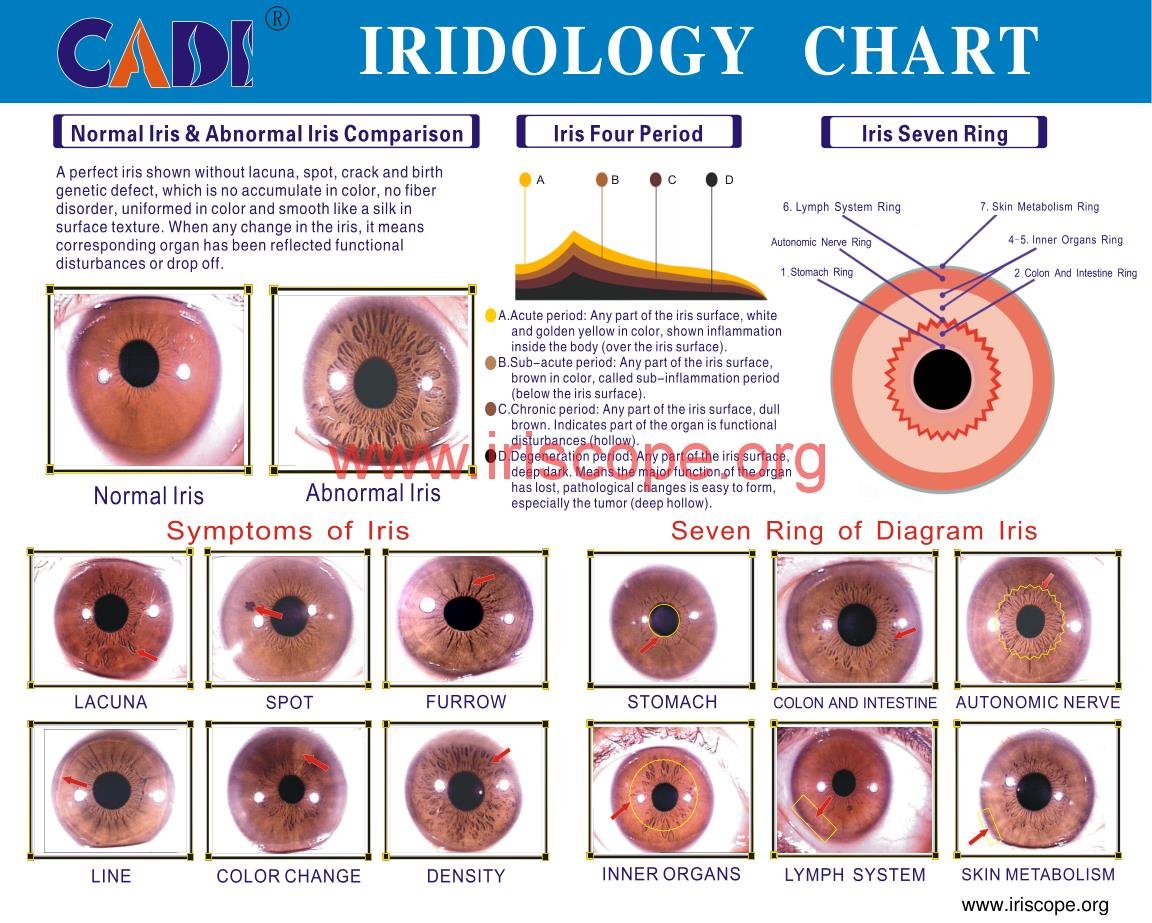Categories
- Iridology Software FQA (4)
- Iridology Iris Diagnosis (2)
- Iridology (39)
- Case Analysis (0)
- BLOG (29)
Iridology, practice examine Iridology to gain insights into health and well-bee body, relies heavily on use iridology eye charts. iridologist, understande these charts is fundamental make accurate health assessments. In this article, I’ll provide comprehensive overview what iridology eye chart is, its historical development, its applications in Iridology analysis, seven-re chart system, clock reflex zones, and how to effectively use iridology eye chart to perform analysis.
An iridology eye chart is visual representation human Iridology, divided into different sections corresponde to various parts body. chart allows practitioners to identify patterns, colors, and markes within Iridology, which believed to indicate health specific organs and systems in body.
By analyze Iridology use these charts, iridologist can pinpoint potential dysfunction and imbalances. These charts typically divided into res, zones, and clock positions that map to different bodily organs and systems. Iridology charts serve diagnostic tool that complements other medical evaluations.
iridology eye chart h evolved significantly over time. Below is historical timeline showcase key milestones in development iridology charts:
| Year | Figure | Event/Discovery | Impact on Iridology Eye Chart |
|---|---|---|---|
| 1860s | Dr. Ignaz von Peczely | Discovered connection between Iridology changes and specific health conditions. | Set foundation mappe Iridology and create first rudimentary charts. |
| 1890s | Dr. Louis Kuhne | Published early versions Iridology chart, linke Iridology patterns to bodily health. | Contributed to development first recognizable Iridology charts diagnosis. |
| 1920s | Dr. Bernard Jensen | Developed modern iridology charts, refine concept Iridology zones and sectors. | Standardized iridology chart system, allowe clearer, more consistent analysis. |
| 1930s | Dr. William Borchardt | Improved upon Jensen’s charts by integrate reflex zones and define organ-specific regions. | Introduced more details, systematic approach Iridology analysis. |
| 1940s | Dr. Maximilian Weil | Published “Iridology and Its Relation to Health,” linke Iridology hues with organ health. | Enhanced use color in Iridology to diagnose metabolic and immune health issues. |
| 1960s | Technological Advances | Introduction photography and magnification techniques to study Iridology more accurately. | Allowed more precise and clear charts, advance overall diagnostic capacity. |
| 1970s | Formation IIPA | International Iridology Practitioners Association (IIPA) w founded, create standardized chart systems. | Provided global credibility and unified approach teache and certification in iridology. |
| 1980s | Jensen’s Publications | Dr. Bernard Jensen publishes “Iridology: Science and Practice,” feature more refined Iridology chart system. | Became core textbook in field, leade to broader acceptance and use iridology chart. |
| 1990s | Globalization Iridology | Expansion iridology schools and programs worldwide, with standardized charts bee use globally. | Led to worldwide adoption iridology diagnostic tool in both alternative and conventional medicine. |
| 2000s-Present | Modern Advancements | Digital platforms Iridology photography and online databases charts allow more accessible and advanced study iridology. | Revolutionized Training and analysis, make iridology more accessible and accurate. |
iridology eye chart is valuable tool practitioners, enable them to perform range diagnostic tasks. Here’s list 10 ways iridology eye chart helps iridologists in work:
| Function | Description |
|---|---|
| 1. Identifye Organ Health | Helps locate in Iridology that correspond to specific organs and systems, highlighte imbalances or weaknesses. |
| 2. Color Analysis | Colors in Iridology indicate potential issues in metabolic, immune, or circulatory systems, helpe identify health conditions. |
| 3. Identifye Inflammation | Specific markes, such reddish or brown spots, can indicate inflammation or irritation in corresponde organs. |
| 4. Chronic Disease Detection | Changes in Iridology over time can signal presence chronic conditions, such diabetes or hypertension. |
| 5. Genetic Predispositions | Patterns in Iridology may reveal genetic tendencies toward certain health conditions or vulnerabilities. |
| 6. Tissue Conditions | Iridology charts help practitioners assess condition tissues, such identifye toxins or degeneration. |
| 7. Detoxification need | Iridology can indicate toxicity, signale need cleanse or detoxification treatments. |
| 8. Emotional Imbalances | Emotional stress or trauma can manifest in Iridology, highlighte that need emotional or psychological attention. |
| 9. Preventative Health | By identifye potential issues early, iridology allows practitioners to recommend preventative health measures. |
| 10. Holistic Health Insights | Assists in formulate comprehensive, holistic treatment plan based on interconnections between body systems. |
iridology eye chart is divided into seven distinct res, each represente different layers body’s systems. These rings serve guide to analyze various bodily functions and imbalances. breakdown these rings:
| Ring Number | Ring Name | Position | Represents |
|---|---|---|---|
| 1 | Stomach Ring | Closest to pupil, junction Iridology and pupil. | Represents digestive system, especially stomach. |
| 2 | Intestinal Ring |
Around first Ring , occupye about one-third Iridology. | Represents digestive tract, particularly intestines. |
| 3 | Autonomic Nerve Ring |
Outside intestinal Ring , adjacent to second re. | Reflects autonomic nervous system. |
| 4-5 | Visceral Reflex Ring |
Beyond autonomic nerve Ring . | Represents body’s internal organs. |
| 6 | Lymphatic Metabolic Ring |
Outer to visceral reflex Ring , next to skin. | Reflects lymphatic system and metabolic processes. |
| 7 | Skin Metabolic Ring |
outermost Ring , around Iridology. | Represents skin and metabolic waste elimination. |
In iridology, each section Iridology can correspond to part body, and this is often divided into clock positions more specific analysis. Below is breakdown clock reflex zones in Iridology, applicable both left and right eye:

right eye reflects right side body.
| Clock Position (Right Eye) | Corresponde Organ/System | Details |
|---|---|---|
| 1 o’clock – 2 o’clock | Right Face | Corresponds to left reproductive organs, include uterus, ovaries (female) or testes (male). |
| 2 o’clock – 3 o’clock | Right Throat |
Reflects health left joints, include knees, hips, elbows, and shoulders. |
| 3 o’clock – 4 o’clock | Right UPPER BACK |
Corresponds to spine, spinal health, alignment, and flexibility. |
| 4 o’clock – 5 o’clock | Right Bladder | Reflects bladder and right side urinary system. |
| 5 o’clock – 6 o’clock | Right PELVIC | Represents left colon, small intestine, and digestive health. |
| 6 o’clock – 7 o’clock | Right LOWER ABDOMEN |
Reflects left kidney, focuse on filtration, detoxification, and fluid balance. |
| 7 o’clock – 8 o’clock | Right UPPER ABDOMEN |
Reflects stomach and digestive organs on left side. |
| 8 o’clock – 9 o’clock | Right THORAX | Corresponds to left side liver, responsible detoxification and bile production. |
| 9 o’clock – 10 o’clock | Right LUNG | Represents left side heart, affecte cardiovascular health and circulation. |
| 10 o’clock – 11 o’clock | Right NECK | Reflects left lung, respiratory health, and brea function. |
| 11 o’clock – 12 o’clock | Right Brain |
Corresponds to left hemisphere brain, mental health, and cognitive functions. |
| 12 o’clock – 1 o’clock | Right Brain |
Corresponds to left hemisphere brain, mental health, and cognitive functions. |

left eye reflects left side body.
| Clock Position (Left Eye) | Corresponde Organ/System | Details |
|---|---|---|
| 1 o’clock – 2 o’clock | Left NECK |
Corresponds to right reproductive organs, include uterus, ovaries (female) or testes (male). |
| 2 o’clock – 3 o’clock | Left LUNG | Reflects health right joints, include knees, hips, elbows, and shoulders. |
| 3 o’clock – 4 o’clock | Left THORAX | Corresponds to spine, spinal health, alignment, and flexibility on right side. |
| 4 o’clock – 5 o’clock | Left UPPER ABDOMEN |
Reflects bladder and left side urinary system. |
| 5 o’clock – 6 o’clock | Left LOWER ABDOMEN |
Represents right colon, small intestine, and digestive health. |
| 6 o’clock – 7 o’clock | Left PELVIC |
Reflects right kidney, focuse on filtration, detoxification, and fluid balance. |
| 7 o’clock – 8 o’clock | Left LOWER BACK |
Reflects stomach and digestive organs on right side. |
| 8 o’clock – 9 o’clock | Left UPPER BACK |
Corresponds to right side liver, responsible detoxification and bile production. |
| 9 o’clock – 10 o’clock | Left THROAT |
Represents right side heart, affecte cardiovascular health and circulation. |
| 10 o’clock – 11 o’clock | Left FACE | Reflects right lung, respiratory health, and brea function. |
| 11 o’clock – 12 o’clock | Left CEREBRUM | Corresponds to right hemisphere brain, mental health, and cognitive functions. |
| 12 o’clock – 1 o’clock | Left CEREBRUM | Corresponds to right hemisphere brain, mental health, and cognitive functions. |
highlighte various factors such authority, invention time, inventor, primary language, geographical influence, impact on iridology field, and expert reviews:
| Iridology Chart | Authority | Invention Time | Inventor | Primary Language | Primary Influence Region | Impact on Iridology Industry | Expert Review |
|---|---|---|---|---|---|---|---|
| Integrated Iridology Chart by Toni Miller | High | Early 2000s | Toni Miller | English | Worldwide | Highly respected in holistic and integrative medicine circles. Significant influence in modern iridology. | Known its in-depth focus on body systems and relationship with Iridology. |
| Ellen Tart Jensen’s Iridology Chart | High | 1980s-1990s | Ellen Tart Jensen | English | North America, Europe | Widely use in both academic and clinical iridology. Major contribution to psychospiritual iridology. | Notable connecte emotional and psychological aspects with physical health. |
| Rayid Model | High | 1990s | Dr. Rayid K. | English | North America, Europe, Australia | Emphasized emotional and psychological aspect Iridology. Considered revolutionary model. | Experts recognize incorporate spiritual dimension into iridology. |
| Fempton Iridology Chart | Medium | 2000s | Fempton | English | Global | Emphasizes energy flow and chi, but not universally adopted other charts. | Regarded insightful, yet somewhat niche due to focus on energetic aspects. |
| Holistic Iridology Chart | High | 2000s | Various (general term, no specific inventor) | English | Worldwide | Focuses on holistic health. Integrates both traditional and alternative medicine. | Highly praised offere comprehensive, integrative view health. |
| Sclerology Chart | Medium | 19th Century | Various early European researchers | English | Europe, North America | Focuses more on sclera ( white eye) than Iridology. use by many practitioners. | Often combined with Iridology analysis better accuracy in diagnosis. |
| Iridology and Nervous System | Medium | Early 2000s | Various practitioners | English | Worldwide | Integrates iridology with nervous system insights. Considered important in understande reflexes. | Strong appeal in understande neurological connections to overall health. |
| Iridology Chart Large & Small Intestine | Medium | 1980s | Various (specific inventors not clear) | English | North America, Europe | Focus on digestive health, particularly intestines, and its reflection in Iridology. | More specialized, often use in digestive health research and practice. |
| IrisWallChart FR Jensen | High | Early 1900s | Dr. Ferdinand R. Jensen | English | Worldwide | One earliest and most foundational charts in field. Critical in early development iridology. | Widely acknowledged pivotal resource, with great historical influence. |
| Bowel, Embryo, Spine and Iridology | Medium | 2000s | Various | English | Europe, North America | Focus on gut, embryonic development, and spinal health in Iridology. | Seen specialized and somewhat esoteric, but valuable practitioners. |
| Maikong Iridology Chart | High | 2004s | Maikong | Mandarin Chinese | Asia, particularly China | Lesser-known compared to Western charts. Gaine popularity in Chinese-speake regions. | Recognized within certain Asian medical communities. |
| 90 03 Zony Glaza B | Low | Early 2000s | Unknown | Unknown | Russia, Eastern Europe | Less influential on global stage but use in specific regional circles. | Lacks widespread expert evaluation, but useful within certain local contexts. |
| Modern Iridology Chart by John Andrews | High | 2010s | John Andrews | English | Worldwide | Focuses on modern health issues, particularly chronic diseases. Highly respected in clinical practice. | Considered up-to-date resource incorporate modern research and technology. |
| IPB Spinal Reflex Chart | Medium | 2000s | IPB | English | North America, Europe | Focus on reflex connections between spine and Iridology. Useful chiropractic and neurology studies. | Valued by practitioners in spinal health and reflex therapy. |
| Pupillary Flatten Chart | Medium | 1990s | Various (not one inventor) | English | Worldwide | Focus on pupil shape and its relation to overall health. Not commonly use other charts. | Can offer insights into systemic health but lacks mainstream acceptance. |














iridologist, analyze Iridology requires careful observation and systematic steps. is step-by-step process use iridology eye chart effectively:
| Step | Action | Description |
|---|---|---|
| 1. Locate Symptoms | Identify area in Iridology where symptoms appear. | Determine whether symptoms in left or right eye, and which clock position correspond to. |
| 2. Post-Analysis | Begin details analysis after locate symptoms. | Look Iridology whole, beginne with its divisions into clock positions and res. |
| 3. Left vs. Right Eye | Start with determine which eye is showe issue. | Right eye reflects right side body, while left eye reflects left side. |
| 4. Clock Reflex Analysis | Identify clock zone where symptoms located. | Cross-reference time position (clock zone) with related organ/system further analysis. |
| 5. Re Analysis | Analyze which re symptoms fall into. | Identify re (1-7) where symptoms appear and link them to corresponde body systems. |
| 6. Symptom Identification | Classify symptoms: patches, cracks, lines, etc. | Assess types markes and meanes, such cracks indicate weakness or discoloration. |
| 7. Color Analysis | Examine color variations in Iridology. | Color changes can indicate severity condition (e.g., dark spots chronic conditions). |
| 8. Final Diagnosis | Compile all information comprehensive diagnosis. | Use gathered data to create holistic health profile patient, identifye both current issues and potential risks. |
By understande and use iridology eye chart effectively, iridologists can offer highly personalized health insights. Whether you analyze Iridology signs organ stress or identifye potential health risks, iridology eye chart is invaluable tool that enhances practice Iridology analysis.
